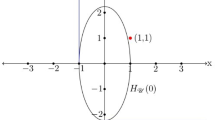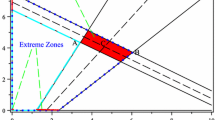Abstract
The multiple-sets split feasibility problem (MSFP) captures various applications arising in many areas. Recently, by introducing a function measuring the proximity to the involved sets, Censor et al. proposed to solve the MSFP via minimizing the proximity function, and they developed a class of simultaneous methods to solve the resulting constrained optimization model numerically. In this paper, by combining the ideas of the proximity function and the operator splitting methods, we propose an efficient simultaneous method for solving the constrained MSFP. The efficiency of the new method is illustrated by some numerical experiments.
Similar content being viewed by others
References
Attouch, H., Briceño-Arias, H.L., Combettes, P.L.: A parallel splitting method for coupled monotone inclusions. SIAM J. Control Optim. 48(5), 3246–3270 (2010)
Baillon, J., Haddad, G.: Quelques propriétés des opérateurs angel-bornés et n-cycliquement monotones. Isr. J. Math. 26, 137–150 (1977)
Bauschke, H.H., Borwein, J.M.: On projection algorithms for solving convex feasibility problems. SIAM Rev. 38, 367–426 (1996)
Bertsekas, D.P., Tsitsiklis, J.N.: Parallel and Distributed Computation: Numerical Methods. Prentice-Hall, Englewood Cliffs (1989)
Byrne, C.: Iterative oblique projection onto convex sets and the split feasibility problem. Inverse Probl. 18, 441–453 (2002)
Byrne, C.: A unified treatment of some iterative algorithms in signal processing and image reconstruction. Inverse Probl. 20, 103–120 (2004)
Byrne, C., Censor, Y.: Proximity function minimization using multiple Bergman projections, with applications to split feasibility and Kullback-Leibler distance minimization. Ann. Oper. Res. 105, 77–98 (2001)
Censor, Y., Elfving, T.: A multiprojection algorithm using Bregman projections in a product space. Numer. Algorithms 8, 221–239 (1994)
Censor, Y., Zenios, S.A.: Parallel Optimization: Theory, Algorithms and Applications. Oxford University Press, New York (1997)
Censor, Y., Elfving, T., Kopf, N., Bortfeld, T.: The multiple-sets split feasibility problem and its applications for inverse problems. Inverse Probl. 21, 2071–2084 (2005)
Censor, Y., Bortfeld, T., Martin, B., Trofimov, A.: A unified approach for inversion problems in intensity-modulated radiation therapy. Phys. Med. Biol. 51, 2353–2365 (2006)
Combettes, P.L.: The convex feasibility problem in image recovery. Adv. Imaging Electron Phys. 95, 155–270 (1996)
Eckstein, J., Fukushima, M.: Some reformulation and applications of the alternating directions method of multipliers. In: Hager, W.W., et al. (eds.) Large Scale Optimization: State of the Art, pp. 115–134. Kluwer Academic, Dordrecht (1994)
Facchinei, F., Pang, J.S.: Finite-Dimensional Variational Inequalities and Complementarity Problems, vols. I and II. Springer, Berlin (2003)
Fukushima, M.: Application of the alternating directions method of multipliers to separable convex programming problems. Comput. Optim. Appl. 2, 93–111 (1992)
Gabay, D.: Applications of the method of multipliers to variational inequalities. In: Fortin, M., Glowinski, R. (eds.) Augmented Lagrangian Methods: Applications to the Numerical Solution of Boundary-Value Problems, pp. 299–331. North-Holland, Amsterdam (1983)
Gabay, D., Mercier, B.: A dual algorithm for the solution of nonlinear variational problems via finite element approximations. Comput. Math. Appl. 2, 17–40 (1976)
Glowinski, R., Le Tallec, P.: Augmented Lagrangian and Operator-Splitting Methods in Nonlinear Mechanics. SIAM, Philadelphia (1989)
Han, D.R.: Inexact operator splitting methods with self-adaptive strategy for variational inequality problems. J. Optim. Theory Appl. 132, 227–243 (2007)
Han, D.R., Xu, W., Yang, H.: An operator splitting method for variational inequalities with partially unknown mappings. Numer. Math. 111, 207–237 (2008)
He, B.S.: Parallel splitting augmented Lagrangian methods for monotone structured variational inequalities. Comput. Optim. Appl. 42, 195–212 (2009)
He, B.S., Liao, L.Z., Han, D.R., Yang, H.: A new inexact alternating direction method for monotone variational inequalities. Math. Program. 92, 103–118 (2002)
He, B.S., Liao, L.Z., Qian, M.J.: Alternating projection based prediction-correction method for structured variational inequalities. J. Comput. Math. 24, 693–710 (2006)
Jiang, Z.K., Yuan, X.M.: New parallel descent-like method for solving a class of variational inequalities. J. Optim. Theory Appl. 145, 311–323 (2010)
Kontogiorgis, S., Meyer, R.R.: A variable-penalty alternating directions method for convex optimization. Math. Program. 83, 29–53 (1998)
Qu, B., Xiu, N.H.: A note on the CQ algorithm for the split feasibility problem. Inverse Probl. 21, 1655–1665 (2005)
Qu, B., Xiu, N.H.: A new halfspace-relaxation projection method for the split feasibility problem. Linear Algebra Appl. 428, 1218–1229 (2008)
Setzer, S.: Split Bregman algorithm, Douglas-Rachford splitting and frame shrinkage. In: Lecture Notes in Comput. Sci., vol. 5567, pp. 464–476 (2009)
Xu, H.K.: A variable Krasnosel’skiı̌-Mann algorithm and the multiple-set split feasibility problem. Inverse Probl. 22, 2021–2034 (2006)
Yang, Q.Z.: The relaxed CQ algorithm solving the split feasibility problem. Inverse Probl. 20, 1261–1266 (2004)
Ye, C.H., Yuan, X.M.: A descent method for structured monotone variational inequalities. Optim. Methods Softw. 22, 329–338 (2007)
Yuan, X.M.: An improved proximal alternating direction method for structured variational inequalities. Comput. Optim. Appl. 49, 17–29 (2011)
Zhang, W.X., Han, D.R., Li, Z.B.: A self-adaptive projection method for solving the multiple-sets split feasibility problem. Inverse Probl. 25. doi:10.1088/0266-5611/25/11/115001
Zhao, J.L., Yang, Q.Z.: Several solution methods for the split feasibility problem. Inverse Probl. 21, 1791–1799 (2005)
Author information
Authors and Affiliations
Corresponding author
Rights and permissions
About this article
Cite this article
Zhang, W., Han, D. & Yuan, X. An efficient simultaneous method for the constrained multiple-sets split feasibility problem. Comput Optim Appl 52, 825–843 (2012). https://doi.org/10.1007/s10589-011-9429-8
Received:
Published:
Issue Date:
DOI: https://doi.org/10.1007/s10589-011-9429-8




